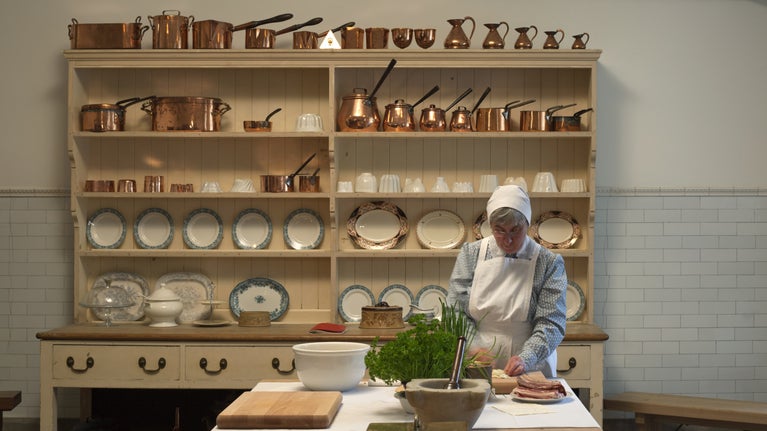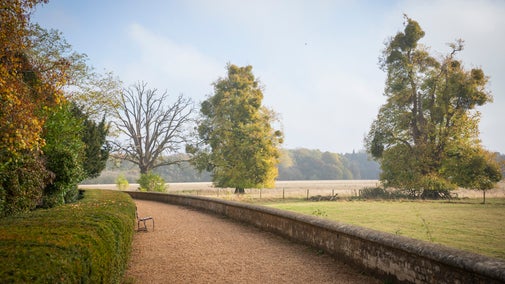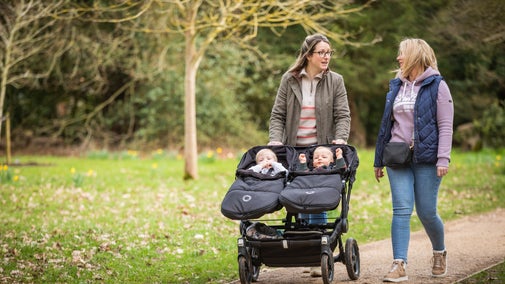
Discover more at Ickworth
Find out when Ickworth is open, how to get here, the things to see and do and more.

While Thomas de Ickworth was the first named owner of the Ickworth estate, and probably founded the church that preceded the existing St Mary’s Church, it wasn’t until the Hervey family acquired Ickworth through marriage in the 15th century that things started to take shape. Learn the stories of some of the key figures in Ickworth’s history.
Inheriting the estate in 1700, John Hervey came to describe it as his ‘centre of rest... Sweet Ickworth'. He was created Baron Hervey of Ickworth in 1703, and was then elevated to an Earldom, choosing Bristol from a choice of titles.
He lived at Ickworth Lodge, a converted farmhouse on the estate (now an annex to the Ickworth Hotel), and spent considerable time and money creating a park worthy of the Hervey name.
The son of the 1st Earl and his second wife, Lord Hervey was a successful politician and pamphleteer. His rise to the high government office of Keeper of the Privy Seal, along with his status as a member of the Privy Council, meant that he became one of the most famous figures of his time. He’s best remembered today for his outspoken memoirs of the court of George II and for his devotion to Queen Caroline.
Lord Hervey's life was full of scandal. He was known for his bisexual relationships and effeminate style, for sharing a mistress with the Prince of Wales, and for having a 10-year relationship with another man. Even so, Lord Hervey never separated from his wife, Mary ‘Molly’ Lepel, herself much admired for her wit and good sense.
He died before his father, so never inherited his father’s title, but his sons became 2nd, 3rd and 4th Earls of Bristol respectively.
A former lady-in-waiting to Queen Caroline, the accomplished Molly Lepel was praised by some of the finest writers of the period, including Voltaire and Pope.
She married Lord John Hervey in secret in 1720. Presumably, this was a love match as neither had money and John’s half-brother Carr Hervey was heir to the Ickworth estate until his death in 1723.
Although John Hervey had apparently tired of the marriage by the mid-1720s and was known to be bisexual, the couple had eight children – four sons (George, Augustus, Frederick and William) and four daughters (Lepel, Mary, Emily and Caroline).

Becoming the 4th Earl despite being a third son, Frederick was known as the Earl Bishop. Dressed top-to-toe in episcopal purple, he became one of the tourist sights of Europe, bowling around Italy in an open-topped carriage and staying in many 'Hotels Bristol' that had been named in his honour.
Mischievous but forward thinking, the 4th Earl was never a religious man and used his position as Bishop of Derry – secured for him by his brother – to dabble in politics, gain great wealth and annoy local vicars.
He died in 1803 on a road in Italy, having had his life’s treasures and art confiscated by Napoleonic troops. It was the Earl Bishop whose vision created the house at Ickworth that we know today.
The death of his father left Frederick, 1st Marquess of Bristol, with a half-built house and an indebted estate. However, he went on to make the single biggest contribution to the development of Ickworth’s landscape. He completed Ickworth House, creating the North and South Pleasure Grounds and Albana Walk, and renewing the 18th-century Walled Garden.
Frederick was born at Ickworth in 1769, the youngest child and second surviving son of the 4th Earl of Bristol and his wife Elizabeth Davers. His parents separated when he was 12 and he was mainly brought up by his mother, never becoming particularly close to his father.
Their distance became most obvious when Frederick refused to marry the illegitimate daughter of the King of Prussia, whom his father had chosen for him. Instead, he married Elizabeth Albana Upton, with whom he had been in love since the pair were at school together. Kindred spirits with a shared attitude, they set about building Ickworth and a landscape to fall in love with – the Albana Walk sitting in the centre of the estate.
A devoted family man and father, Frederick viewed Ickworth as a home rather than a place of the arts. Along with his wife and children, he moved into the East Wing of Ickworth House in 1829 following the completion of extensive construction works to turn it into a living space.
Following the death of his father in 1803, Frederick took responsibility for completing the development of Ickworth. By 1818, though, building work had stopped as funds were short. Frederick had only inherited £1,000 (excluding the landed estates that were passed down to him) and he wanted to complete other building projects before focusing his attention on Ickworth.
However, after receiving an injection of funds from his mother’s brother and the Davers family, he was able to continue working on the Ickworth estate, finishing the East Wing among other things.

While Ickworth was being finished, Frederick took his wife and their four children – all aged under 17 – on a four-year tour of Europe. During this time, he attempted to recover the art collection that had been confiscated from his father by the French. Though his efforts largely failed, one significant re-purchase was John Flaxman’s Fury of Athamus, which now stands proudly inside the Entrance Hall of the Rotunda.
With a much smaller art collection than his father had imagined, Frederick had the West Wing built not as an assembly room, but merely to provide the essential balance of the architectural design. He focused more attention on the Rotunda, decorating and furnishing the ground floor, putting in a rudimentary set of stairs, and finishing the rooms on the first floor. The Dining Room and Library are clear examples of Frederick’s legacy.
A great lover of horticulture, the 1st Marquess played a pivotal role in the development of Ickworth’s garden. As a Fellow of the Royal Society, he would have listened to many talks on the subject and built up a good level of knowledge. Frederick’s natural interest in gardening was reinforced by his wife, who was equally keen, and the couple enjoyed the process of planning and creating the garden at Ickworth.
Even while construction was halted on Ickworth’s physical buildings, Frederick and Elizabeth continued their work outdoors and set about implementing the earliest Italianate garden in England, inspired by the gardens at Caserta, near Naples.
The granddaughter of Victorian railway contractor George Wythes, and holder of an immense personal fortune, Alice Theodora Wythes came to Ickworth after marrying Frederick, the 4th Marquess (1863–1951). It was the couple’s shared passion for their home, as well as Theodora’s wealth, that enabled the estate to prosper before it was passed on to the National Trust in 1956.
Theodora’s money paid for the settling of debts and major improvements to the house, including new servants’ quarters, electric lighting, the latest in Edwardian plumbing and alterations to the great show rooms in the Rotunda.
Theodora was also greatly concerned with the contents of the house. She catalogued, cleaned and rehung the picture collection, as well as having the book collection listed and rebound, and the furniture and objets d’art restored. She compiled scrapbooks of pictures associated with the Hervey family, and sought to purchase any that came on the market.
The 6th Marquess led an extraordinary life, earning the nickname 'Mayfair Playboy No. 1'. He joined a gang of ‘gentleman’ jewel thieves, and was convicted in 1939 on two counts of robbery from Mayfair addresses. He also dabbled in dubious arms sales. In contrast, his later life was one of extreme respectability; in 1960, he inherited the title of 6th Marquess, and he subsequently became chairman of the Monarchist League.
The life of the 7th Marquess was as remarkable as those of his forebears. Rumoured in the press to have blown a £21 million fortune on vice and high living, he ended up selling many of his remaining family possessions. After briefly marrying in the 1980s, John moved out of the East Wing at Ickworth in 1996 – thus ending the Hervey family’s association with the estate.

Life as a servant at Ickworth was subject to the whims of the resident family and their guests. It was hard graft with long hours. There was a strict hierarchy among the servants, and life could be incredibly tough.
Theodora became concerned by the hardships of her servants, and over the years did much to improve living conditions. She renovated the Rotunda servants’ quarters with the latest technology, adding electric lights, hot water boilers and new bathrooms.
Though the servants undoubtedly had a hard life looking after the family, our research reveals that they had a good relationship with Theodora. She was probably the first lady of the house to visit them in the basement, going down to the kitchen to consult with the cook and taking morning prayers for the female servants.
The staff also had some downtime. In the Servants’ Hall, there's a shove ha’penny board scored into the dining table, and they would have enjoyed pastimes such as playing cards, bagatelle or tiddlywinks, playing the piano and reading newspapers and magazines.

Find out when Ickworth is open, how to get here, the things to see and do and more.
Discover Ickworth’s fascinating history, from the people who’ve lived here over the centuries, to how it came to be what you see today.

Ickworth is home to one of the most important collections of 18th-century silver in Europe. Learn more about the collection at Ickworth in Suffolk.

Discover the house and the treasures collected by the flamboyant 4th Earl of Bristol at Ickworth, a magnificent Italianate palace in the heart of Suffolk.

Ickworth's garden was the first of its kind in the UK. Designed for privacy, space and freedom, it's a distillation of the gardens of classical Italy given an individual English touch.

Explore the parkland at Ickworth, encircled with layers of history, landscape and classic architecture. Enjoy space, freedom and inspiring views as you wander at your leisure.

From landscape gardeners to LGBTQ+ campaigners and suffragettes to famous writers, many people have had their impact on the places we care for. Discover their stories and the lasting legacies they’ve left behind.

Learn about people from the past, discover remarkable works of art and brush up on your knowledge of architecture and gardens.
